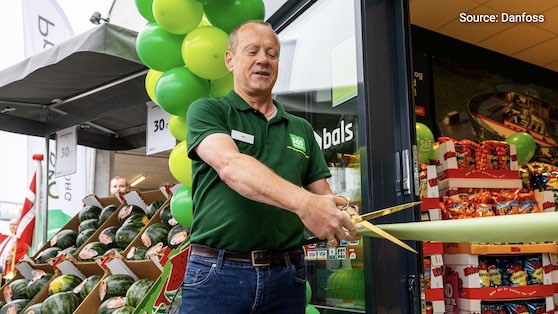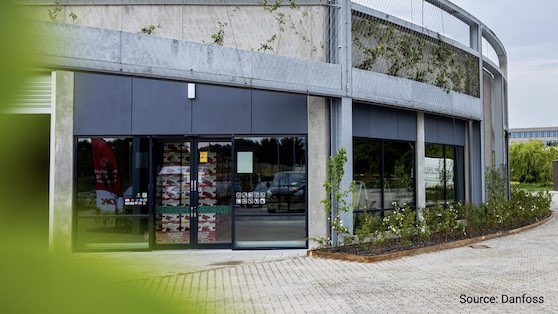
Cleantech
Features
Net Zero
News
News
Danfoss presents its super-efficient supermarket and test bed in Nordborg
July 18, 2023 By Anthony Capkun
 Per Juhl, store manager, cuts the ribbon to open the smart supermarket in Nordborg, Denmark. Source: Danfoss.
Per Juhl, store manager, cuts the ribbon to open the smart supermarket in Nordborg, Denmark. Source: Danfoss. July 18, 2023 – Supermarkets and retail food stores are an integral part of communities around the world, but they are also big energy consumers. Yet, as large as they may be, the average profit margin for a large food retailer is just 1.7%, which puts every operating cost under scrutiny.
Energy efficiency is an area in which significant savings can be achieved with relatively low investment and good payback times. In fact, because the profit margins of supermarkets are so thin, Energy Star estimates that $1.00 US in energy savings is equivalent to increasing sales by $59.00 US.
Accordingly, Danfoss proudly announced the opening of its flagship, 21st-century supermarket building, which is expected to be approximately 50% more energy-efficient compared to a typical supermarket with a first-generation CO2 refrigeration system and no energy efficiency solutions.
The supermarket is also expected to be about 20% to 30% more efficient than an equivalent local store already fitted with multiple energy efficiency solutions.
In case you are wondering, Danfoss has not become a grocer.
Instead, Denmark’s largest independent supermarket association—BALS (Brugsforeningen for Als and Sundeved)—will rent the building from Danfoss, and install a COOP 365discount supermarket.
BALS has a total of 13 stores in the area around Sønderborg and, since 2015, has consistently reduced the consumption of energy in its stores. So far, BALS has cut 44% of their total CO2 emissions and, as such, Danfoss says it was a “natural next step” that BALS became a partner in the smart store project.
“Our 13 supermarkets have been modernized, and we have nearly no cost for heating in the stores because the heat comes from our freon-free refrigeration systems, solar cells, and heat pumps,” said Lars G. Andersen, managing director, BALS. “It is an advantage with the current energy prices, and it reduces our CO2 emissions. We are proud to be part of one of the most energy-efficient supermarkets in the world, and test the solutions that can help buildings become climate neutral.”

The Danfoss smart supermarket in Nordborg, Denmark. Source: Danfoss.
The range of solutions in the Danfoss smart store demonstrate the savings that can be achieved in supermarkets, with a typical payback of three to four years.
“We have developed this new ‘smart store’ supermarket with partners and customers to demonstrate that it is possible to build a climate friendly and super-efficient facility, using world-class heating and cooling technology,” said Jürgen Fischer, president, Danfoss Climate Solutions, when commenting on the launch.
The supermarket also serves as a test site for new technologies, Fischer explained. This is why, for example, the supermarket has two separate refrigeration systems that run independently of each other. As future applications get tested on one system, the cooling cabinets and freezers stay cool thanks to the second system.
Solar power is the supermarket’s primary energy source, with 100-kW solar panels on the building’s roof supporting supermarket operations.
Heat capture and reuse are also key to the supermarket’s energy efficiency, with an up to 90% reduction in heating costs anticipated.
In fact, excess heat is the world’s largest untapped source of energy, according to Danfoss. As such, the store is fitted with heat recovery units designed to recover the waste heat from all the refrigeration systems. The recovered heat is reused to heat up the store and produce domestic hot water. Any additional heat is shared with nearby townsfolk through a district energy network.
Energy Star notes that refrigeration and lighting account for over 50% of total energy use in the average supermarket, making these systems the best places to start looking for energy efficiency opportunities.
The Nordborg smart store’s other initiatives, such as installing doors on refrigerator and freezer cases, will save around a third on energy use, while the choice of LED lighting uses up to 85% less electricity than incandescent bulbs.
Automation and monitoring of the store add another layer of energy savings.
“For the first time, all of Danfoss’ most cutting-edge technology and energy-efficient food retail solutions are being brought together into one retail site,” Fischer said.
“This supermarket is purpose-built for the world ahead of us: a world of more urbanization, larger populations, greater energy demands, a growing need for cooling, and efficient food storage,” Fischer added.
Importantly, the installations and technologies in the supermarket are scalable, Danfoss notes, as they can be applied “in the smallest store up to the biggest hypermarket”.
Print this page